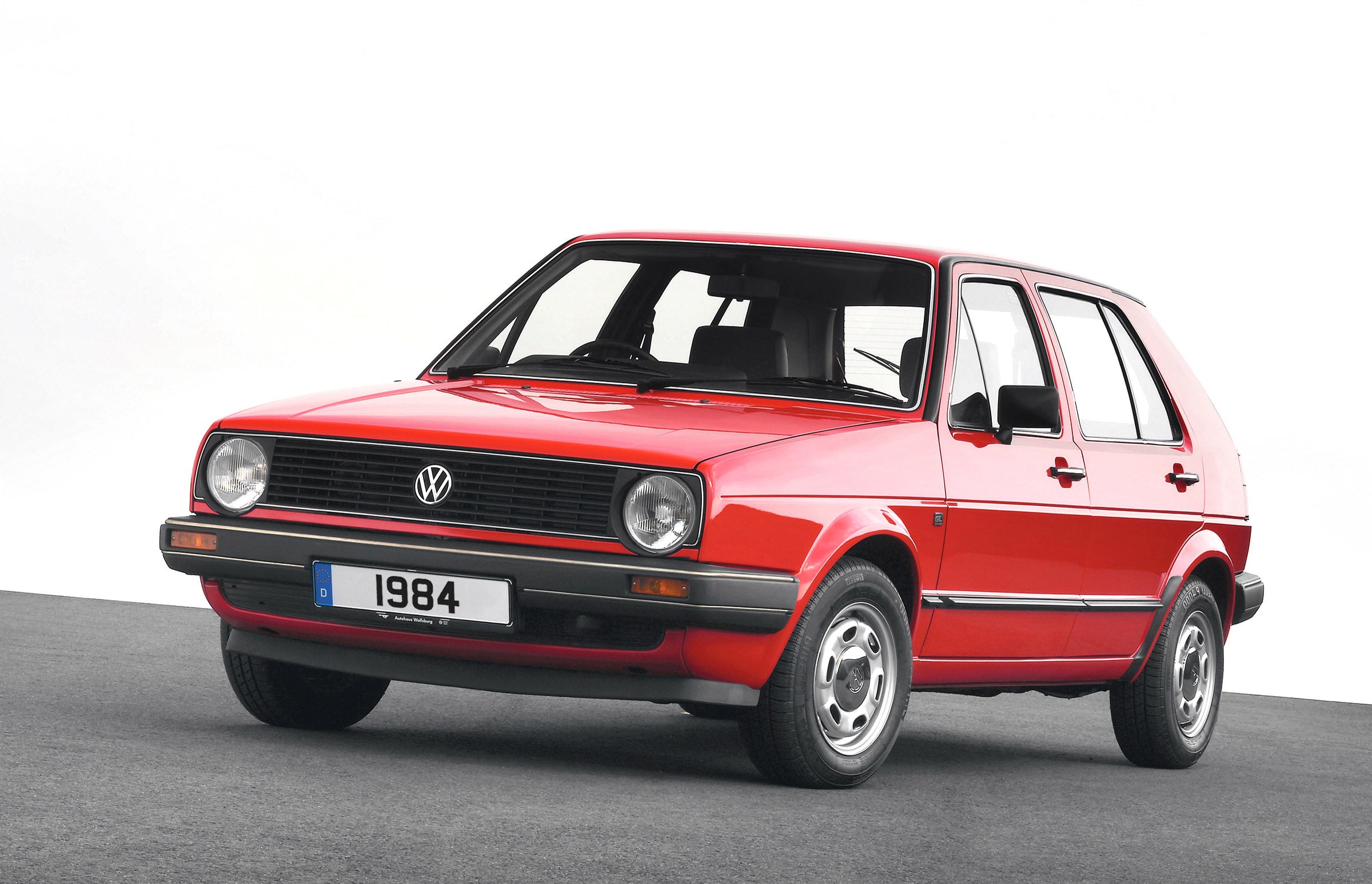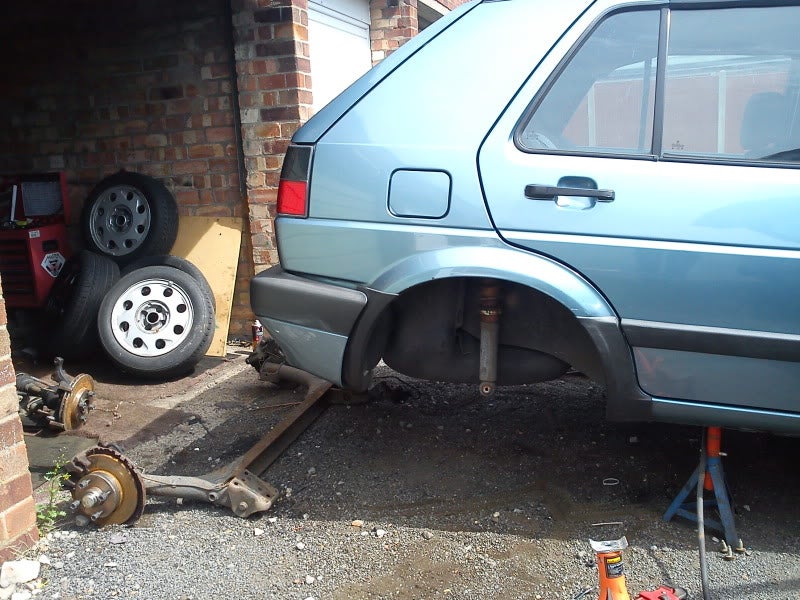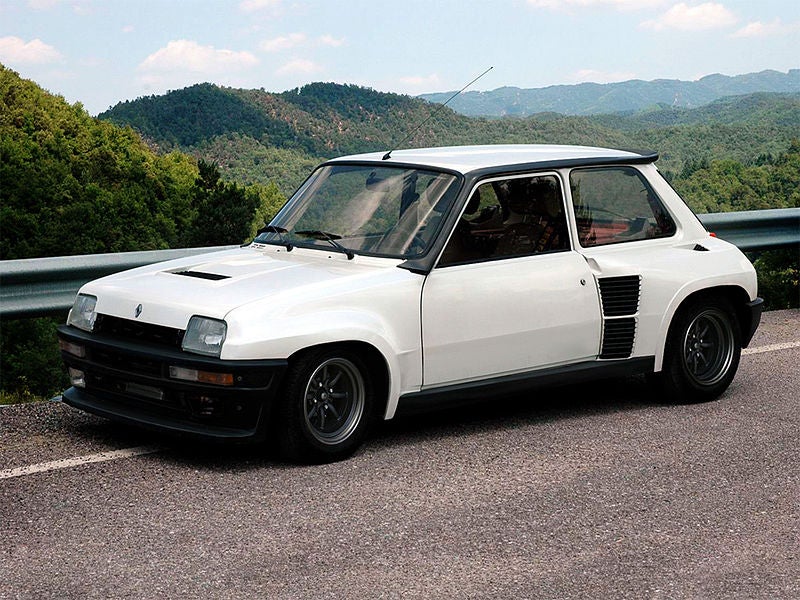 "Harrycarry250" (Harrycarry250)
"Harrycarry250" (Harrycarry250)
12/10/2013 at 16:15 • Filed to: None
 0
0
 18
18
 "Harrycarry250" (Harrycarry250)
"Harrycarry250" (Harrycarry250)
12/10/2013 at 16:15 • Filed to: None |  0 0
|  18 18 |
I am constantly dreaming up projects to do with cars and my car. I never really get past the online-window-shopping phase but it is still very fun. Yesterday I wanted to buy a Volvo 240 and drop an xc90 V8 in there, last week I wanted to fit a scania turbo to my 300tdt, and now I want to put an engine in the back of a old VW hatch.

I would like to put a 4 cylinder or 6 cylinder motor in the back of a VW Golf or Rabbit. I want to flare out my rear wheel arches and add some air intakes like the car above. So I want to ask some questions, just for fun because we all know this build will never happen. I can dream!
Where do I put the gas tank?
Will I get horrendous understeer with no weight in the front?
Where do I put radiator? Right above the engine like an old Porsche or in the front?
If the gas tank is in the front it will make front end collisions much worse.
Am I better off using a completely different rear end than trying to modify the existing?
As I think of more questions I will add. Thanks!

 davedave1111
> Harrycarry250
davedave1111
> Harrycarry250
12/10/2013 at 16:20 |
|
"The obviously the Renault, not a VW but this guy has an engine in the back that the factory put in."
Renault? Pretty sure that's a Lambo Peugeot, dude.
 Aya, Almost Has A Cosmo With Toyota Engine Owned by a BMW.
> Harrycarry250
Aya, Almost Has A Cosmo With Toyota Engine Owned by a BMW.
> Harrycarry250
12/10/2013 at 16:39 |
|
Well, i once drove my friend's Clio V6, looong time ago. And it's quite hard to drive, because you get all the power to the rear wheels, so when you're turning that thing, be very light on the power or you'll oversteer, and maybe spun out.
 KillerRaccoon - Group J's Sébastien Loeb
> Harrycarry250
KillerRaccoon - Group J's Sébastien Loeb
> Harrycarry250
12/10/2013 at 16:40 |
|
No, you will not get horrendous understeer if you lower the spring rates to account for the lower weight. There's less weight over the wheels, so less grip, but also less weight to turn in. Overall, it will turn better because tires deal slightly worse with higher loads, etc.
Front radiator would be easiest, smartest and will improve weight distribution. I would personally just say fuck it and put the gas tank in front as well.

Regarding the rear end, you can see from this picture that it uses an extremely crude rear end. I'm not going to get into specifics, but it would be completely unsuitable for driven wheels for myriad reasons. You could either study up on suspension geometry ( Tune to Win is a good starting point) and design and fabricate your own rear end or grab it from a Lotus with a wrecked front or something.
!!! UNKNOWN CONTENT TYPE !!!
 Harrycarry250
> davedave1111
Harrycarry250
> davedave1111
12/10/2013 at 16:42 |
|
my bad
 Harrycarry250
> KillerRaccoon - Group J's Sébastien Loeb
Harrycarry250
> KillerRaccoon - Group J's Sébastien Loeb
12/10/2013 at 16:44 |
|
The lotus rear end is a very good idea. As for the radiator and gas tank, they would live up front.
 Alex87f
> Harrycarry250
Alex87f
> Harrycarry250
12/10/2013 at 16:49 |
|
I don't know much about technical stuff but I know a few things about group B cars and I've read a few similar build threads.. Maybe this'll help..
Where do I put the gas tank?
In some group B cars (think R5 Turbo), it was located behind and under the seats to keep the weight low.
Wont I get horrendus understeer with no weight in the front?
Which is probably why you'll try to aim for 50 / 50 weight distribution. And it probably heavily depends on the suspension setup too.
Where do I put radiator? Right above the engine like a old Porsche or in the front?
As far as I recall it's quite often in front. Most of those cars are turbocharged so you already need room for the intercooler.
If the gas tank is in the front it will make front end collisions much worse .
You're talking about a heavily modified race car, I don't think this matters much anymore. For what it's worth, R5 turbo's had their tanks under and behind the seats (as said earlier), and Renault had put a fiberglass cylinder in the front trunk pretty much where the engine block would have sit, in order to have something in place of the engine in the event of a collision.
That being said, the passengers were sitting on 25 gallons of fuel, so any heavy accident usually turned into a BBQ.
Am I better off using a completely different rear end than trying to modify the existing?
Most people who do the conversion nowadays use a complete drivetrain of a FF transverse (engine, gearbox and suspension) car and put it in the back. You can probably start from scratch, but ultimately you'll have to source components from another car, unless you want to machine you own...
Keep in mind that this kind of conversion takes hundreds of hours even to very experienced professional. One of the build threads I read ended with the guy scrapping the whole car because he had made a calculation mistake whilst designing the rear chassis and found his rear wheels to be 4" to far in front..
 erspimp03
> Harrycarry250
erspimp03
> Harrycarry250
12/10/2013 at 16:54 |
|
Here's a full picture walk-through for how to do it on the cheap. I'd estimate that if you invested enough time, you could accomplish this for 3-4 grand, minus the cost of any engine modifications.
http://honda-tech.com/showthread.php…
Essentially, pull the front subframe and suspension off a donor car and weld it into the back of another one. If you haven't done an engine swap before and don't at least own a decent welder, you may want to start off a bit more basic. Good projects that are simple and relatively cheap include volvo small block v8 swaps, golf vr6 swaps, and civic b-series swaps.
 Harrycarry250
> Alex87f
Harrycarry250
> Alex87f
12/10/2013 at 16:54 |
|
Thank you for the input. If I use an FF drivetrain how would I deal with the no obsolete steering assembly? Another user mentioned swapping over a crashed Lotus drivetrain.
 davedave1111
> Harrycarry250
davedave1111
> Harrycarry250
12/10/2013 at 16:57 |
|
The Renault's this one:

Makes the Pug look almost discreet.
 Alex87f
> Harrycarry250
Alex87f
> Harrycarry250
12/10/2013 at 16:58 |
|
Yep, this is probably a good idea but keep in mind that a Lotus is a fast 750-800kg car. Swap its 120 to 140-ish hp drivetrain (probably not cheap btw) into a 1 100 or 1 200kg caged car and it won't be that quick anymore. And it will have a shitty performance-gain-to-work-input ratio.
The steering assembly is indeed a headscratcher. I don't remember how they had done it, but it had been completely neutralized (think steering crank removed, etc.) and the suspension components might have been modified accordingly.
 duurtlang
> KillerRaccoon - Group J's Sébastien Loeb
duurtlang
> KillerRaccoon - Group J's Sébastien Loeb
12/10/2013 at 16:59 |
|
These mk2 Golfs came from the factory as syncros, so with driven rear wheels. Don't know if they were available in the US though.
 DocWalt
> duurtlang
DocWalt
> duurtlang
12/10/2013 at 17:05 |
|
Probably easier to just put the front subframe under the rear. The rear syncro subframe is not well suited to doing much beyond holding a differential.
 KillerRaccoon - Group J's Sébastien Loeb
> Harrycarry250
KillerRaccoon - Group J's Sébastien Loeb
> Harrycarry250
12/10/2013 at 17:08 |
|
Alex's idea of using a whole front end is actually great, a solution I had forgotten about. The only issue is it will have some non-ideal suspension geametry for RWD, but not too bad. That's actually basically what GM did with the Fiero.
However, what he says about 50/50 weight distribution isn't quite right. 50/50 is not ideal for sports cars, it will transition the most neutrally, but that's actually not what you want. A little rear bias (usually around 40/60 f/r or a little more rear bias) helps the rear of the car attain its ideal slip angle more quickly, basically because it has more momentum, whereas the front has steering to help it attain its ideal slip angle more quickly. 50/50 would work fine, but I really would shoot for 40/60 if I were you.
 duurtlang
> Alex87f
duurtlang
> Alex87f
12/10/2013 at 17:09 |
|
My bare bones 3-door mk2 Golf is, according to the official papers, 820 or 840 kg. This is excluding driver and possibly fluids though, and obviously excluding a cage. But I bet you can rip quite a lot out of them to save weight.
 KillerRaccoon - Group J's Sébastien Loeb
> Harrycarry250
KillerRaccoon - Group J's Sébastien Loeb
> Harrycarry250
12/10/2013 at 17:12 |
|
With regards to the steering assembly, that's actually useful to have around. You remove the steering itself, but what used to be tie rods can now be toe angle adjustors.
 Harrycarry250
> KillerRaccoon - Group J's Sébastien Loeb
Harrycarry250
> KillerRaccoon - Group J's Sébastien Loeb
12/10/2013 at 17:23 |
|
I would like to use the front end from another VW. The hardest part besides the installation of the front end assembly would be getting the whole darn thing installed straight and true to the vehicle. Sounds like a 40/60 weight dist would be fairly easy to achieve with an engine in the back.
 KillerRaccoon - Group J's Sébastien Loeb
> Harrycarry250
KillerRaccoon - Group J's Sébastien Loeb
> Harrycarry250
12/10/2013 at 17:28 |
|
A VR6 would be super rad.
 Alex87f
> duurtlang
Alex87f
> duurtlang
12/11/2013 at 03:01 |
|
Well a roll cage adds about 50kg. I assume this is entirely negated by the weight you can remove from the car (interior, isolation, normal seats, etc..).
But then you've got to account for the heavier engine, rims, brakes (hopefully!!), rear suspension setup and rear chassis, which I would guess adds at least 100kg. So you're looking at a 130-ish, 930kg RWD Golf 2.
It wouldn't be slow, but a GTI 16v with a few improvements would probably be quicker in every single regard, cost way less and remain legal and practical.
Or you can get an MG TF which has the same engine as a Lotus Elise (1.8 rover), is already RWD, and is legal and not too hard to come by for cheap. Add a few chassis / power improvements and again this will be a quicker and cheaper alternative. Plus, it's a convertible.
This is why I'd question using this powertrain, and the idea of the swap altogether.